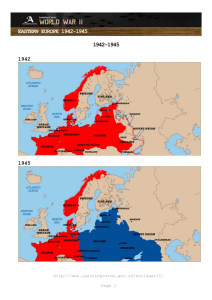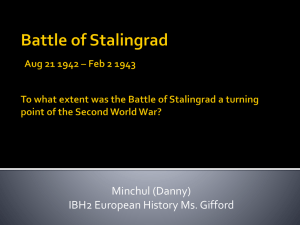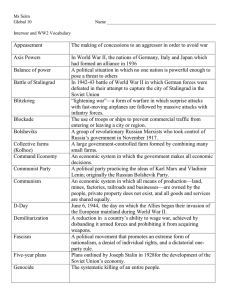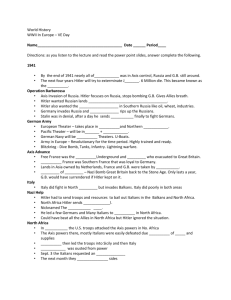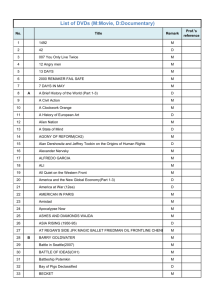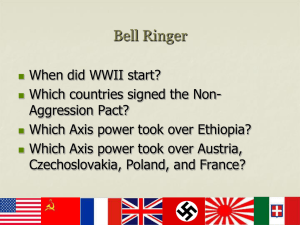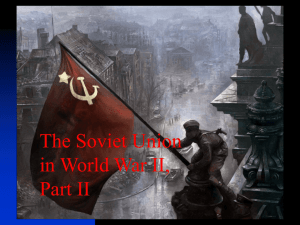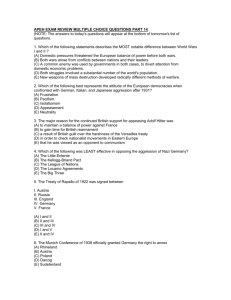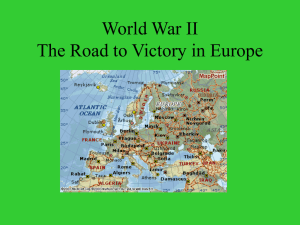The key question:
advertisement
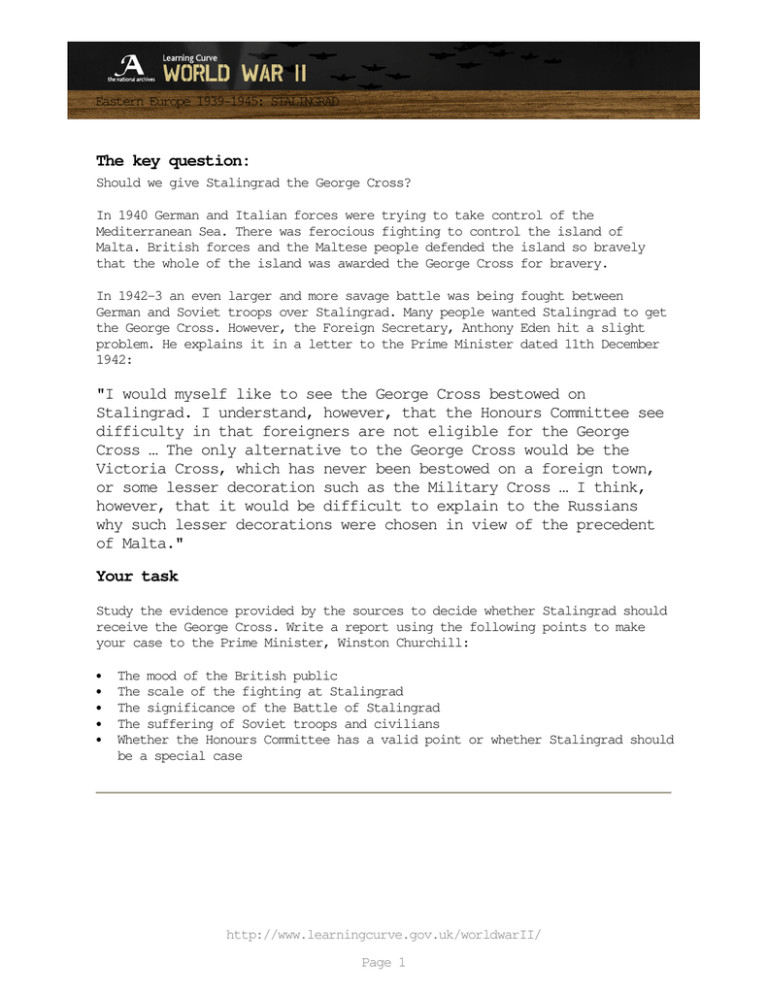
Eastern Europe 1939-1945: STALINGRAD The key question: Should we give Stalingrad the George Cross? In 1940 German and Italian forces were trying to take control of the Mediterranean Sea. There was ferocious fighting to control the island of Malta. British forces and the Maltese people defended the island so bravely that the whole of the island was awarded the George Cross for bravery. In 1942-3 an even larger and more savage battle was being fought between German and Soviet troops over Stalingrad. Many people wanted Stalingrad to get the George Cross. However, the Foreign Secretary, Anthony Eden hit a slight problem. He explains it in a letter to the Prime Minister dated 11th December 1942: "I would myself like to see the George Cross bestowed on Stalingrad. I understand, however, that the Honours Committee see difficulty in that foreigners are not eligible for the George Cross … The only alternative to the George Cross would be the Victoria Cross, which has never been bestowed on a foreign town, or some lesser decoration such as the Military Cross … I think, however, that it would be difficult to explain to the Russians why such lesser decorations were chosen in view of the precedent of Malta." Your task Study the evidence provided by the sources to decide whether Stalingrad should receive the George Cross. Write a report using the following points to make your case to the Prime Minister, Winston Churchill: • • • • • The mood of the British public The scale of the fighting at Stalingrad The significance of the Battle of Stalingrad The suffering of Soviet troops and civilians Whether the Honours Committee has a valid point or whether Stalingrad should be a special case http://www.learningcurve.gov.uk/worldwarII/ Page 1 Eastern Europe 1939-1945: STALINGRAD A letter to the Prime Minister, September 1942 Catalogue ref: FO 371/33035 http://www.learningcurve.gov.uk/worldwarII/ Page 2 Eastern Europe 1939-1945: STALINGRAD What is this source? This source is a letter sent to British Prime Minister Winston Churchill in September 1942. The letter was actually handled by the Foreign Office because that department handled issues relating to other countries. What’s the background to this source? Hitler’s main aim was to conquer a large empire in Eastern Europe. To do this he needed to defeat the USSR. In June 1941 he launched Operation Barbarossa. This was a devastating lightning attack on the USSR. Soviet leader Stalin seriously considered surrendering. Only the arrival of a Russian winter stopped the German advance in 1941. In 1942 the Germans launched a new offensive in the south of the USSR. They wanted to capture the oilfields of the Caucasus region. The key to this area was the large city of Stalingrad. At first the Germans were very successful. They reached the edge of the city by the end of July 1942. However, from this point on they had to fight their way through the wreckage of the bombed and shelled city. At the time of this letter, the Germans were slowly driving Soviet forces back, but with heavy casualties. It's worth knowing that… The city controlled the River Volga, a key transport route. Of course it had huge symbolic importance because it was named after Soviet leader, Josef Stalin. Its capture would have been a major propaganda achievement. The Germans did not have enough resources to attack Moscow, the capital of the USSR. They attacked Stalingrad because they thought it would bring them an easy victory. How will you use this source? 1. What do the three typists want Churchill to do? 2. Where do you think the typists might have got their information about events in Stalingrad? http://www.learningcurve.gov.uk/worldwarII/ Page 3 Eastern Europe 1939-1945: STALINGRAD 3. Does this letter help you to measure the mood of the British public? 4. Does this source help you to understand the importance of the Battle of Stalingrad, or what it was like to be there? 5. Is there any part of this source you would quote in your final report to the Prime Minister? Use the report table to help plan your report. http://www.learningcurve.gov.uk/worldwarII/ Page 4 Eastern Europe 1939-1945: STALINGRAD A letter written to the Prime Minister, December 1942 Catalogue ref: FO 371/33035 Transcript of letter 30th December 1942 Dear Sir, Although I realise your time must be very fully occupied may I, with diffidence, respectfully ask that the attention of our great Prime Minister be drawn to the suggestion that the signal honour to a great city of the George Cross be recommended for bestowal by His Majesty. The Prime Minister probably knows more than anyone in Great Britain of what the defence of heroic Stalingrad meant in 'sweat, blood, tears' against almost overwhelming odds in ‘planes, weapons, equipment during months of truly spartan resistance by its unbeatable garrison and civilian population. http://www.learningcurve.gov.uk/worldwarII/ Page 5 Eastern Europe 1939-1945: STALINGRAD Such an epic defence is an inspiration and example to all haters of brutal and callous aggression and the suggested honour would, I respectfully suggest, carry the whole hearted support of all British and Empire peoples besides being a unique gesture of good will and friendship. What is this source? This letter was written to British Prime Minister Winston Churchill in 1942. You can see from the way that this letter has been written that the author expected it to be read by Churchill’s officials. However, it is unlikely that the Prime Minister read such letters, but his officials would have given him some idea of their content. What’s the background to this source? Hitler’s main aim was to conquer a large empire in Eastern Europe. To do this he needed to defeat the USSR. In June 1941 he attacked the USSR and conquered huge amounts of territory. In 1942 the Germans launched a new offensive in the south of the USSR. They wanted to capture the oilfields of the Caucasus region. The key to this area was the large city of Stalingrad. Again, the Germans were successful at first. They made big gains in July-August 1942. By the end of October they were still advancing slowly. However, the incredibly fierce resistance of Soviet forces and civilians in Stalingrad halted the German advance late in 1942. By the end of the year the tide was beginning to turn against the Germans. German successes were based on fast moving attacks where artillery, tanks, aircraft and infantry all worked closely together. They were co-ordinated by use of radio. In Stalingrad the rubble of destroyed buildings made tanks much less effective. The Soviets also used clever tactics which they called ‘hugging’ the Germans. This meant fighting them hand to hand as much as possible. This meant that the Germans could not use their artillery or air power for fear of hitting their own troops. It was a bloody and brutal struggle and both sides suffered very heavy casualties. It’s worth knowing that... A key factor in turning the tide against the Germans in 1942 was the Soviet winter. German troops were not well equipped for the freezing weather. This http://www.learningcurve.gov.uk/worldwarII/ Page 6 Eastern Europe 1939-1945: STALINGRAD was partly because they expected Stalingrad to have fallen earlier in the year. Back in Germany there were appeals to the civilian population to donate clothing, especially fur coats, for the soldiers on the Eastern Front. How will you use this source? 1. 2. 3. 4. What does the letter writer want? Does the writer seem well informed about events in Stalingrad? Does the letter help you to measure the mood of the British public? Does this source help you to understand the importance of the Battle of Stalingrad? 5. Is there any part of this source that you would quote in your final report to the Prime Minister? http://www.learningcurve.gov.uk/worldwarII/ Page 7 Eastern Europe 1939-1945: STALINGRAD A letter written to the Prime Minister in October 1942 Catalogue ref: FO 371/33035 http://www.learningcurve.gov.uk/worldwarII/ Page 8 Eastern Europe 1939-1945: STALINGRAD Transcript of this letter 3rd October 1942 The Right Hon. Winston Churchill, M.P., 10, Downing Street. S.W.1 Sir I very respectfully suggest that you recommend for the consideration of His Majesty the King the immediate award of the George Cross or similar honour to the people of Stalingrad for the epic defence of their city and their contribution to the cause of the United Nations. I have the Honour to be, Sir, Your obedient servant, P. Findlay Mills What is this source? This letter was written to British Prime Minister Winston Churchill in 1942. You can see from the way that this letter has been written that the author expected it to be read by Churchill’s officials. However, it is unlikely that the Prime Minister read such letters, but his officials would have given him some idea of their content. What's the background to this source? Hitler’s main aim was to conquer a large empire in Eastern Europe. To do this he needed to defeat the USSR. In June 1941 he attacked the USSR and conquered huge amounts of territory. In 1942 the Germans launched a new offensive in the south of the USSR. They wanted to capture the oilfields of the Caucasus region. The key to this area was the large city of Stalingrad. Again, the Germans were successful at first. They made big gains in July-August 1942. By the end of October they were still advancing slowly. However, the incredibly fierce resistance of Soviet forces and civilians in Stalingrad halted the German advance late in 1942. By the end of the year the tide was beginning to turn against the Germans. German successes were based on fast moving attacks where artillery, tanks, aircraft and infantry all worked closely together. They were co-ordinated by use of radio. In Stalingrad the rubble of destroyed buildings made tanks much less effective. The Soviets also used clever tactics which they called http://www.learningcurve.gov.uk/worldwarII/ Page 9 Eastern Europe 1939-1945: STALINGRAD ‘hugging’ the Germans. This meant fighting them hand to hand as much as possible. This meant that the Germans could not use their artillery or air power for fear of hitting their own troops. It was a bloody and brutal struggle and both sides suffered very heavy casualties. It's worth knowing that... A key factor in turning the tide against the Germans in 1942 was the Soviet winter. German troops were not well equipped for the freezing weather. This was partly because they expected Stalingrad to have fallen earlier in the year. Back in Germany there were appeals to the civilian population to donate clothing, especially fur coats, for the soldiers on the Eastern Front. How will you use this source? 1. 2. 3. 4. What does the letter writer want? Does the writer seem well informed about events in Stalingrad? Does the letter help you to measure the mood of the British public? Does this source help you to understand the importance of the Battle of Stalingrad? 5. Is there any part of this source that you would quote in your final report to the Prime Minister? http://www.learningcurve.gov.uk/worldwarII/ Page 10 Eastern Europe 1939-1945: STALINGRAD An official War Office map from February 1943 Catalogue ref: WO 208/1768 http://www.learningcurve.gov.uk/worldwarII/ Page 11 Eastern Europe 1939-1945: STALINGRAD What is this source? This is an official War office map used to plot the advance of Soviet forces against the Germans in 1943. The War Office was the government department in charge of the armed forces. Today it is called the Ministry of Defence. Senior commanders and politicians would have used this map. What's the background to this source? Hitler’s main aim was to conquer a large empire in Eastern Europe. In June 1941 he attacked the USSR. At first his forces were successful and the USSR was close to collapse. In the spring of 1942 he attacked the southern USSR. Again his forces advanced at first but they were then held back at Stalingrad. In a bloody battle lasting several months Germans forces were gradually surrounded and then defeated. By early 1943 they were being driven back out of the USSR. The Soviet winters of 1941 and 1942 proved to be key allies. Winter halted the German advance in 1941. In 1942 German troops were not prepared for winter conditions in the USSR. Many died from starvation and cold in Stalingrad. Many historians believe that this battle was the turning point of World War 2. It's worth knowing that... The Soviet general who masterminded the victory at Stalingrad was General Zhukov. He is still a hero in the USSR today. His statue can be seen outside Red Square in Moscow. Zhukov was an intelligent commander and a quick learner. After Stalingrad he copied many of the Germans’ tactics. He quickly recognised the importance of fast moving tanks supported by aircraft. The rest of the war on the Eastern front was dominated by giant tank battles. How will you use this source? 1. How does this map help historians to see how bad the situation was in October 1942? 2. What do you think the mood would have been in the War Cabinet at that time? 3. How much ground did the Soviets take back by February 1943? http://www.learningcurve.gov.uk/worldwarII/ Page 12 Eastern Europe 1939-1945: STALINGRAD 4. Many historians see Stalingrad as the turning point in WW2. How does this map help to explain that view? 5. Is there any part of this source you would quote in your final report to the Prime Minister? Use the report table to help plan your report. http://www.learningcurve.gov.uk/worldwarII/ Page 13 Eastern Europe 1939-1945: STALINGRAD Extract from a letter from the Soviet ambassador in London, Ivan Maisky, to British Foreign Secretary, Anthony Eden Catalogue ref: FO 371/37021 http://www.learningcurve.gov.uk/worldwarII/ Page 14 Eastern Europe 1939-1945: STALINGRAD What is this source? This extract comes from a letter from Soviet ambassador Maisky to British Foreign Secretary Anthony Eden. He was responding to an earlier letter from Eden. In 1943 the British people raised huge amounts of money to help Stalingrad. Maisky wrote to Eden asking for Stalingrad to be supplied with essential equipment for communications, power and medicine. Eden said that Britain could not supply this equipment because its industries were all geared to war production. This letter is Maisky’s response to Eden’s refusal. What's the background to this source? Hitler’s main aim was to conquer a large empire in Eastern Europe. In June 1941 he attacked the USSR. At first his forces were successful and the USSR was close to collapse. In the spring of 1942 he attacked the southern USSR. Again his forces advanced at first but they were then held back at Stalingrad. In a bloody battle lasting several months Germans forces were gradually surrounded and then defeated. By early 1943 they were being driven back out of the USSR. The Soviet winters of 1941 and 1942 proved to be key allies. Winter halted the German advance in 1941. In 1942 German troops were not prepared for winter conditions in the USSR. Many died from starvation and cold in Stalingrad. Many historians believe that this battle was the turning point of World War 2. It's worth knowing that... Stalingrad was completely devastated during the battle.The city was flattened by bombing and months of fighting. It is estimated that there were around 1.1 Soviet casualties in the battle. When the Germans first bombed the city at the start of the battle it is estimated that 40 000 civilians were killed. Disease and malnutrition affected both sides by the end of the battle. Of the 91 000 German soldiers taken prisoner at the end of the battle only about 5000 returned to Germany. How will you use this source? 1. According to Maisky, why is Stalingrad special? http://www.learningcurve.gov.uk/worldwarII/ Page 15 Eastern Europe 1939-1945: STALINGRAD 2. What would have happened if Stalingrad had fallen? 3. Maisky was upset because Eden had refused a request for essential equipment to help rebuild Stalingrad. Does this mean his claims are more or less valid? 4. The money for the equipment Maisky wanted had been raised by British voluntary donations. What does this tell you about the popular mood in Britain? 5. Is there any part of this source you would quote in your final report to the Prime Minister? Use the report table to help plan your report. http://www.learningcurve.gov.uk/worldwarII/ Page 16 Eastern Europe 1939-1945: STALINGRAD Extract from a British newsreel called Liberation of Stalingrad- Epic Report, March 1943 ITN Ref: BP010343107313 Courtesy of ITN/Source, London. Transcript of this source The Russian ring closes round the 6th German Army at Stalingrad. The great liberation offensive bears down on 22 trapped Nazi divisions representing 330,000 doomed men. The end of 163 days of siege. The history of warfare has never known such an encirclement and annihilation of so large a number of regular troops. Hundreds of thousands of bodies lie frozen and in around the city. Almost as many died in the appalling conditions of the last few weeks. They rot in the land which they wanted to enslave. Field Marshall Paulus’s army has been eaten away by the Soviet forces and now nothing remains of it. The twisted, disordered relics of an army committed to destruction by Adolph Hitler. Before the final surrender the advance line of this legion of lost men was strung out across the open spaces once the residential quarter of worker?s settlement General Rokosovsky, Marshall Voronhov and General Batar. Three names which will live in the immortal story of Stalingrad. Marshall Voronhov, representative of the High Command, figured prominently in the dramatic capture of Paulus. Russian gunners firing point black over open sights at the remaining points of enemy resistance. Amazing pictures which show the final hours of fighting in Stalingrad as the last strongholds are silenced. The Nazis lay down their arms. The voice of the Moscow commentator who described these official newsreel pictures to Russian audiences is heard telling how whole detachments gave themselves up when the end came. What is this source? This is a newsreel clip from 1943 covering events in Stalingrad and the Eastern Front generally. http://www.learningcurve.gov.uk/worldwarII/ Page 17 Eastern Europe 1939-1945: STALINGRAD It was broadcast on March 1st 1943 when footage from Russia would have been made available to make the broadcast. What's the background to this source? Hitler’s main aim was to conquer a large empire in Eastern Europe. In June 1941 he attacked the USSR. At first his forces were successful and the USSR was close to collapse. In the spring of 1942 he attacked the southern USSR. Again his forces advanced at first but they were then held back at Stalingrad. In a bloody battle lasting several months Germans forces were gradually surrounded and then defeated. By early 1943 they were being driven back out of the USSR. The Soviet winters of 1941 and 1942 proved to be key allies. Winter halted the German advance in 1941. In 1942 German troops were not prepared for winter conditions in the USSR. Many died from starvation and cold in Stalingrad. Many historians believe that this battle was the turning point of World War 2. It's worth knowing that... The German forces and their allies suffered an estimated 850,000 casualties at Stalingrad. Soviet casualties are estimated at around 1.1 million. German forces also included Italian, Hungarian and Romanian troops. These were less well trained or equipped than German troops. In fact the main Soviet breakthroughs were gained by attacking these forces that were based on the wings of the German army. How will you use this source? 1. What does this source tell historians about the type of fighting that took place at Stalingrad? 2. What differences can you observe between German and Soviet forces? 3. Do you think we get a full picture of the campaign from this clip? 4. How would you describe the tone of this newsreel? 5. What does the commentary on the newsreel tell historians about attitudes in Britain towards the USSR and Stalingrad in particular? 6. Is there any part of this source you would quote in your final report to the Prime Minister? http://www.learningcurve.gov.uk/worldwarII/ Page 18 Eastern Europe 1939-1945: STALINGRAD Extract from a British newsreel called Salute to the Red Army, February 1943 ITN Ref: BP250243107312 Courtesy of ITN/Source, London. Transcript of this source ...pageantry is at London's Albert Hall where drama, verse and music combine in an impressive demonstration. The British government's tribute to the USSR 5000 people and more witness a magnificent spectacle during which the stage is dressed with the uniforms of men and women marshalled in such a way as to make each and all of them significant parts in a grand design. Here now are some highlights from a speech given by Mr. Eden: "In three months, the Red army has reconquered all the territory wrested from it by the Germans during the summer of last year. And more besides. Much more besides. For the Red Army has driven into the minds of the German people, that German troops can be defeated, and hurled into the confusion of retreat." What is this source? This extract comes from a newsreel clip broadcast on February 25th 1943. It shows part of the ceremony in London to celebrate the Soviet victory at Stalingrad. The news of the German surrender came through in early February 1943, so the celebrations were organised fairly quickly. What's the background to this source? Hitler’s main aim was to conquer a large empire in Eastern Europe. In June 1941 he attacked the USSR. At first his forces were successful and the USSR was close to collapse. In the spring of 1942 he attacked the southern USSR. Again his forces advanced at first but they were then held back at Stalingrad. In a bloody battle lasting several months Germans forces were gradually surrounded and then defeated. By early 1943 they were being driven back out of the USSR. The Soviet winters of 1941 and 1942 proved to be key allies. Winter halted the German advance in 1941. In 1942 German troops were not prepared for winter conditions in the USSR. Many died from starvation and cold in Stalingrad. Many historians believe that this battle was the turning point of World War 2. http://www.learningcurve.gov.uk/worldwarII/ Page 19 Eastern Europe 1939-1945: STALINGRAD It's worth knowing that... The full news report was about 7 minutes long. It showed scenes similar to the London scenes taking place in all the major cities of Britain. The parades must have taken up a lot of manpower and effort in the middle of the war. This suggests that British people were aware of just how important the Soviet victory was and how grateful the British people were for that victory. How will you use this source? 1. What were the ceremonies trying to represent? 2. The speaker was the Foreign Secretary, Anthony Eden. Does his speech help historians to understand the significance of the Battle of Stalingrad? 3. How would you describe the tone of this newsreel? 4. Does this source tell historians about the popular mood in Britain with regard to the USSR and Stalingrad in particular? 5. Is there any part of this source you would quote in your final report to the Prime Minister? http://www.learningcurve.gov.uk/worldwarII/ Page 20 Eastern Europe 1939-1945: STALINGRAD Extract from a film called Stalingrad receives the King's sword, May 1944 ITN Ref: BP250544135818 Courtesy of ITN/Source, London. Transcript of this source A delegation of Stalingrad citizens in the Kremlin attending the ceremony whereat the Sword of Honour, gift of King George to the people of Stalingrad, is handed over. Marshall Budenny stands in the foreground as the great two handed sword is brought in. Marshall Budenny takes the sword from the bearer and hands it over to the chairman of Stalingrad City Council. What is this source? This clip comes from a newsreel broadcast on May 1944. It shows part of a ceremony that took place at the Kremlin in Moscow. Marshal Semyon Mikhailovitch Budenny presents the Sword of Stalingrad to the Chairman of the Stalingrad City Council. The sword is a gift from King George VI. What's the background to this source? Hitler’s main aim was to conquer a large empire in Eastern Europe. In June 1941 he attacked the USSR. At first his forces were successful and the USSR was close to collapse. In the spring of 1942 he attacked the southern USSR. Again his forces advanced at first but they were then held back at Stalingrad. In a bloody battle lasting several months Germans forces were gradually surrounded and then defeated. By early 1943 they were being driven back out of the USSR. The Soviet winters of 1941 and 1942 proved to be key allies. Winter halted the German advance in 1941. In 1942 German troops were not prepared for winter conditions in the USSR. Many died from starvation and cold in Stalingrad. Many historians believe that this battle was the turning point of World War 2. http://www.learningcurve.gov.uk/worldwarII/ Page 21 Eastern Europe 1939-1945: STALINGRAD It's worth knowing that... The rest of the newsreel shows various shots inside the Russian Embassy in London where the Russian Ambassador bestows the Medal of Honour on Air Chief Marshal Harris (“Bomber” Harris), General Alanbrook and Admiral Tovey. In 1943 the city of Coventry, one of Britain’s most heavily bombed, was twinned with Stalingrad. This was the first example of town ‘twinning’. This suggests that British people were aware of just how important the Soviet victory was and how grateful the British people were for that victory. How will you use this source? 1. 2. 3. 4. What was the purpose of the ceremony? How would you describe the tone of this newsreel? Do you think this an appropriate honour for Stalingrad? Is there any part of this source you would quote in your final report to the Prime Minister? http://www.learningcurve.gov.uk/worldwarII/ Page 22 Eastern Europe 1939-1945: STALINGRAD Should we give Stalingrad the George Cross? Study the evidence provided by the sources to decide whether stalingrad should receive the george cross. Write a report using the points in the table to make your case to the prime minister, winston churchill. The mood of the British public The scale of the fighting at Stalingrad The significance of the Battle of Stalingrad The suffering of Soviet troops and civilians Should Stalingrad be a special case for the award of the George Cross? http://www.learningcurve.gov.uk/worldwarII/ Page 23
